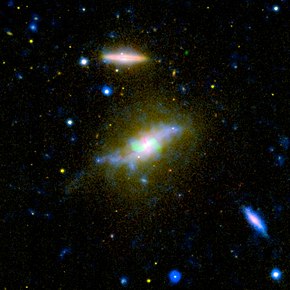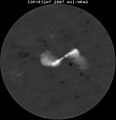NGC 3801
| NGC3801 | |
|---|---|
 Multiwavelength image of NGC 3801, from ultraviolet to radio | |
| Observation data (J2000epoch) | |
| Constellation | Leo |
| Right ascension | 11h40m16.9s[1] |
| Declination | +17° 43′ 41″[1] |
| Redshift | 0.011064 ± 0.000007[1] |
| Heliocentric radial velocity | 3,317 ± 2km/s[1] |
| Distance | 169± 38Mly(51.9 ± 11.6Mpc)[1] |
| Apparent magnitude(V) | 12.0[2] |
| Characteristics | |
| Type | S0/a[1] |
| Apparent size(V) | 3.5′× 2.1′[2] |
| Notable features | merger remnant, radio galaxy |
| Other designations | |
| UGC6635,MCG+03-30-040, 4C +17.52,PGC36200[1] | |
NGC 3801is alenticular galaxylocated in the constellationLeo.It is about 150 millionlight yearsfrom Earth, and estimated to be about 170,000 light years in diameter.William Herscheldiscovered it on 17 April 1784.[3]
Characteristics
[edit]The morphology of NGC 3801 is disturbed, indicating that the galaxy underwent amergerwith another gas rich galaxy.[4]A dust lane runs across the galaxy in its eastern half while a smaller one is visible perpendicular to that along the minor axis. Atidal tailabout 1.2 arcminutes long extends to the east-southeast of the galaxy. Thehalo of the galaxyappears boxy.[5]
NGC 3801 has been found to emit radio waves. It is a compactFanaroff–Rileytype Iradio galaxy,with the total extent of the jets being 40 arcseconds. Both jets appear to curve while the core is not visible in observations by the Very Large Array.[6]Theradio jetshave been found to heat theinterstellar mediumto a temperature of 1 and 0.7keV.[7]A linear feature is visible in soft X-rays extending along the jet axis, possibly a tidal tail.[7]
CO imaging indicates the presence of an edge-on disk with a radius 2 kpc perpendicular to the radio jets axis, with a molecular gas mass of3×108M☉,about 1% of the dynamical mass of the galaxy. There is also a clump of molecular gas not associated with the disk that appears to fall towards the galaxy.[6]The radio jet axis is aligned with the main HI disk of the galaxy.[4]
When observed inultraviolet,the galaxy is shaped like an s-shape, with the western half being brighter than the eastern half, indicating the presence of a very warped disk. Both halves extend for 60–70 arcseconds. Small UV clumps appear along the galaxy, that indicate the presence of stars. The age of the stellar population in the clumps is estimated to be between 100 and 500 Myr, with most star forming activity taking place before 400 Myr. The location of the most vigorousstarburstappears to be the central region of the galaxy.[8]
In the centre of NGC 3801 lies asupermassive black holewhose mass is estimated to be 108.28 ± 0.31(93 – 390 millions)M☉based on gas dynamics[9]or108.43M☉based on stellarvelocity dispersion.[7]The nucleus of the galaxy has been categorised as in between aSeyfert galaxyand aLINER.[8]
Nearby galaxies
[edit]NGC 3801 is the foremost galaxy of thegalaxy groupknown as NGC 3801 group or LGG 246. Other members of the group include the galaxiesNGC 3768,NGC 3790,NGC 3799,NGC 3800,NGC 3802,NGC 3806,NGC 3827,and NGC 3853.[10]NGC 3802 lies 2.3 arcminutes from NGC 3801 while NGC 3790 lies 7 arcminutes away.[11]HI imaging shows a hydrogen bridge that appears to link NGC 3801 and NGC 3802, indicating the two galaxies are interacting.[4]
Gallery
[edit]-
NGC 3801 bySloan Digital Sky Survey
-
NGC 3801 by theHubble Space Telescope
-
NGC 3801 by theVery Large Array
-
NGC 3801 (middle) andNGC 3790(right),NGC 3802(above NGC 3801),NGC 3803(small galaxy at the top) andNGC 3806(upper left). Image by thelegacy surveys
See also
[edit]- 3C 285- a similar radio galaxy
References
[edit]- ^abcdefg"NASA/IPAC Extragalactic Database".Results for NGC 3801.Retrieved2016-01-18.
- ^ab"Revised NGC Data for NGC 3801".spider.seds.org.Retrieved25 November2018.
- ^NGC 3801cseligmanCelestial Atlas
- ^abcEmonts, B. H. C.; Burnett, C.; Morganti, R.; Struve, C. (1 April 2012)."Classical radio source propagating into outer H i disc in NGC 3801: Large-scale H i disc in NGC 3801".Monthly Notices of the Royal Astronomical Society.421(2): 1421–1430.arXiv:1112.5221.doi:10.1111/j.1365-2966.2011.20402.x.S2CID118666200.
- ^Heckman, T. M.; Smith, Eric P.; Baum, Stefi A.; van Breugel, W. J. M.; Miley, G. K.; Illingworth, G. D.; Bothun, G. D.; Balick, B. (December 1986). "Galaxy collisions and mergers - The genesis of very powerful radio sources?".The Astrophysical Journal.311:526.Bibcode:1986ApJ...311..526H.doi:10.1086/164793.
- ^abDas, Mousumi; Vogel, Stuart N.; Verdoes Kleijn, Gijs A.; O’Dea, Christopher P.; Baum, Stefi A. (20 August 2005). "BIMA Millimeter-Wave Observations of the Core-Jet and Molecular Gas in the FR I Radio Galaxy NGC 3801".The Astrophysical Journal.629(2): 757–766.arXiv:astro-ph/0505285.Bibcode:2005ApJ...629..757D.doi:10.1086/431640.S2CID16263625.
- ^abcCroston, J. H.; Kraft, R. P.; Hardcastle, M. J. (May 2007). "Shock Heating in the Nearby Radio Galaxy NGC 3801".The Astrophysical Journal.660(1): 191–199.arXiv:astro-ph/0702094.Bibcode:2007ApJ...660..191C.doi:10.1086/513500.S2CID7797196.
- ^abHota, Ananda; Rey, Soo-Chang; Kang, Yongbeom; Kim, Suk; Matsushita, Satoki; Chung, Jiwon (May 2012)."NGC 3801 caught in the act: a post-merger star-forming early-type galaxy with AGN-jet feedback: NGC 3801: AGN feedback caught in the act?".Monthly Notices of the Royal Astronomical Society: Letters.422(1): L38–L42.arXiv:1111.5325.doi:10.1111/j.1745-3933.2012.01231.x.S2CID30363280.
- ^Bosch, Remco C. E. van den (2 November 2016)."Unification of the Fundamental Plane and Super Massive Black Hole Masses".The Astrophysical Journal.831(2): 134.arXiv:1606.01246.Bibcode:2016ApJ...831..134V.doi:10.3847/0004-637X/831/2/134.S2CID119216147.
- ^Garcia, A. M. (1 July 1993)."General study of group membership. II. Determination of nearby groups".Astronomy and Astrophysics Supplement Series.100:47–90.Bibcode:1993A&AS..100...47G.ISSN0365-0138.
- ^Nilson, P. (1 January 1973)."Uppsala General Catalogue of Galaxies, 1973, Acta Universitatis Upsalienis, Nova Regiae Societatis Upsaliensis, Series v: a Vol".Nova Acta Regiae Soc. Sci. Upsaliensis Ser. V.Bibcode:1973UGC...C...0000N.
External links
[edit] Media related toNGC 3801at Wikimedia Commons
Media related toNGC 3801at Wikimedia Commons- NGC 3801 onWikiSky:DSS2,SDSS,GALEX,IRAS,Hydrogen α,X-Ray,Astrophoto,Sky Map,Articles and images
- NGC 3801 on SIMBAD




